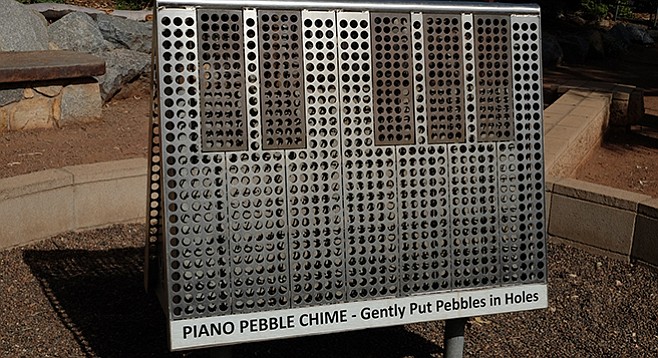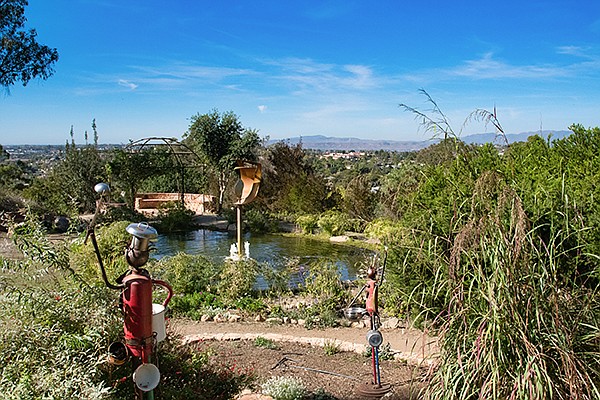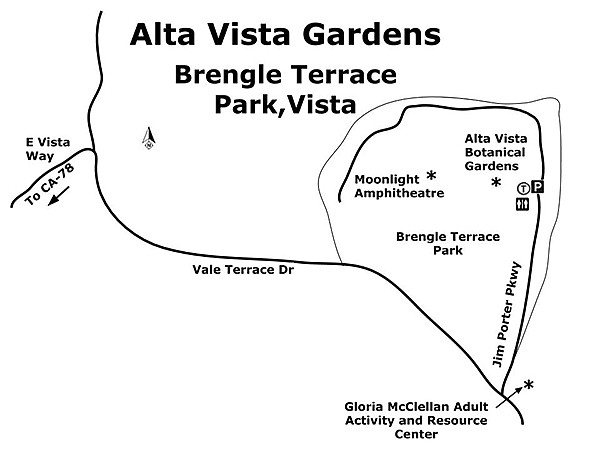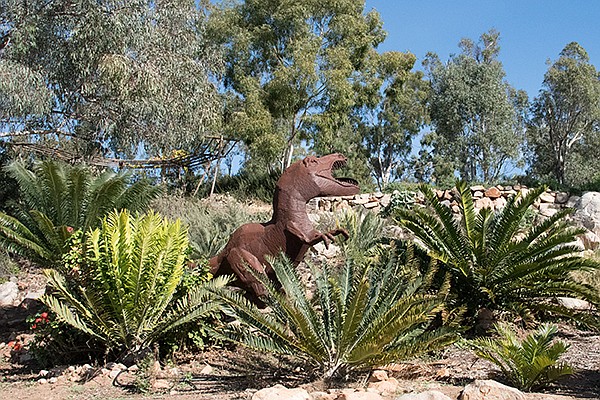 Facebook
Facebook
 X
X
 Instagram
Instagram
 TikTok
TikTok
 Youtube
Youtube

Alta Vista Botanical Gardens was designed and largely constructed by the environmental artist and contractor Bryan Morse, as well as by a host of dedicated volunteers. It is a work in progress and completely dependent on volunteer labor, material donations, and financial contributions. The Gardens promote the involvement of the community by offering courses such as yoga and periodic events such as a big Earth Day celebration each year. Everything is designed to bring people together in this delightful natural setting.

The 11 acres of the Gardens crown a hill at the top of Vista’s Brengle Terrace Park, with views out to the ocean on clear days. There are nearly a dozen themed gardens, each containing plantings relating to the theme, with artworks by contemporary artists thoughtfully placed within them. A network of paths connects the gardens, making for many surprising discoveries as you go from garden to garden. If you experience just the gardens described here, you will easily have walked one mile — possibly more, depending on the paths you select.

The Children’s Garden may be the most enthusiastically received. On the Discovery Trail, 19 boxes pose questions that can be answered by examining a nearby plant, so that children learn some tools for exploring the environment. Other exhibits found here encourage children to be physically active and engage in free play, particularly the Stumps and Logs and the Tubular Tunnels. The most exciting artwork is Ricardo Breceda’s huge serpent sculpture that slithers in and out of a bed of asparagus ferns. The Children’s Garden also houses the Jeffrey Stein Children’s Music Garden, with instruments that let children create intriguing and interesting sounds, even tunes.

The Prehistoric Garden features a survivor of the Jurassic era, a Wollemia Pine (Wollemia nobilis). It was only known from fossils until 1994, when a living grove of the tree was found in New South Wales, Australia. Seedlings of the Wollemia Pine were purchased for the Garden, and are now growing here in Vista. This Garden also has a collection of living cycads, more common survivors from the Jurassic era. The artwork within the Prehistoric Garden includes welded sculptures of the herbivore triceratops, a dinosaur that may have eaten cycads, and Tyrannosaurus rex, a dinosaur that may have eaten triceratops. Both are the work of the imaginative artist Ricardo Breceda.
Other gardens include a South African Garden, an Arid Garden featuring a Desert Oasis with Aloe and Agave Collections, as well as Native Californian, Mediterranean, Jungle and Australasian Gardens. The Native Garden has California native plants as its theme, though most of the plants are not labeled. You can take this opportunity to practice identifying them. Additionally, there are California native plants, mostly coastal sage scrub and chaparral, growing throughout the Garden.
Driving Directions: (Vista) From I-5, merge onto SR-78 and continue east five miles. Exit SR-78 and merge onto Vista Village Drive. Continue north 1.6 miles on Vista Village Drive to Vale Terrace Drive. Take a right turn on Vale Terrace Drive and follow the signs for Alta Vista Gardens. The gardens are within Vista’s much larger Brengle Terrace Park, which also contains the Moonlight Amphitheater and numerous sports and picnic facilities. Park in one of the spaces provided, opposite the entrance.
Hiking length: 1+ miles, out and back.
Difficulty: Easy. Minimal elevation gain/loss. Allow 1.5 hours hiking time.
Other: The Gardens open at 8:00 a.m. during the week and at 10:00 a.m. on the weekends. There is a $5.00 entrance fee for non-members.


Alta Vista Botanical Gardens was designed and largely constructed by the environmental artist and contractor Bryan Morse, as well as by a host of dedicated volunteers. It is a work in progress and completely dependent on volunteer labor, material donations, and financial contributions. The Gardens promote the involvement of the community by offering courses such as yoga and periodic events such as a big Earth Day celebration each year. Everything is designed to bring people together in this delightful natural setting.

The 11 acres of the Gardens crown a hill at the top of Vista’s Brengle Terrace Park, with views out to the ocean on clear days. There are nearly a dozen themed gardens, each containing plantings relating to the theme, with artworks by contemporary artists thoughtfully placed within them. A network of paths connects the gardens, making for many surprising discoveries as you go from garden to garden. If you experience just the gardens described here, you will easily have walked one mile — possibly more, depending on the paths you select.

The Children’s Garden may be the most enthusiastically received. On the Discovery Trail, 19 boxes pose questions that can be answered by examining a nearby plant, so that children learn some tools for exploring the environment. Other exhibits found here encourage children to be physically active and engage in free play, particularly the Stumps and Logs and the Tubular Tunnels. The most exciting artwork is Ricardo Breceda’s huge serpent sculpture that slithers in and out of a bed of asparagus ferns. The Children’s Garden also houses the Jeffrey Stein Children’s Music Garden, with instruments that let children create intriguing and interesting sounds, even tunes.

The Prehistoric Garden features a survivor of the Jurassic era, a Wollemia Pine (Wollemia nobilis). It was only known from fossils until 1994, when a living grove of the tree was found in New South Wales, Australia. Seedlings of the Wollemia Pine were purchased for the Garden, and are now growing here in Vista. This Garden also has a collection of living cycads, more common survivors from the Jurassic era. The artwork within the Prehistoric Garden includes welded sculptures of the herbivore triceratops, a dinosaur that may have eaten cycads, and Tyrannosaurus rex, a dinosaur that may have eaten triceratops. Both are the work of the imaginative artist Ricardo Breceda.
Other gardens include a South African Garden, an Arid Garden featuring a Desert Oasis with Aloe and Agave Collections, as well as Native Californian, Mediterranean, Jungle and Australasian Gardens. The Native Garden has California native plants as its theme, though most of the plants are not labeled. You can take this opportunity to practice identifying them. Additionally, there are California native plants, mostly coastal sage scrub and chaparral, growing throughout the Garden.
Driving Directions: (Vista) From I-5, merge onto SR-78 and continue east five miles. Exit SR-78 and merge onto Vista Village Drive. Continue north 1.6 miles on Vista Village Drive to Vale Terrace Drive. Take a right turn on Vale Terrace Drive and follow the signs for Alta Vista Gardens. The gardens are within Vista’s much larger Brengle Terrace Park, which also contains the Moonlight Amphitheater and numerous sports and picnic facilities. Park in one of the spaces provided, opposite the entrance.
Hiking length: 1+ miles, out and back.
Difficulty: Easy. Minimal elevation gain/loss. Allow 1.5 hours hiking time.
Other: The Gardens open at 8:00 a.m. during the week and at 10:00 a.m. on the weekends. There is a $5.00 entrance fee for non-members.
Comments